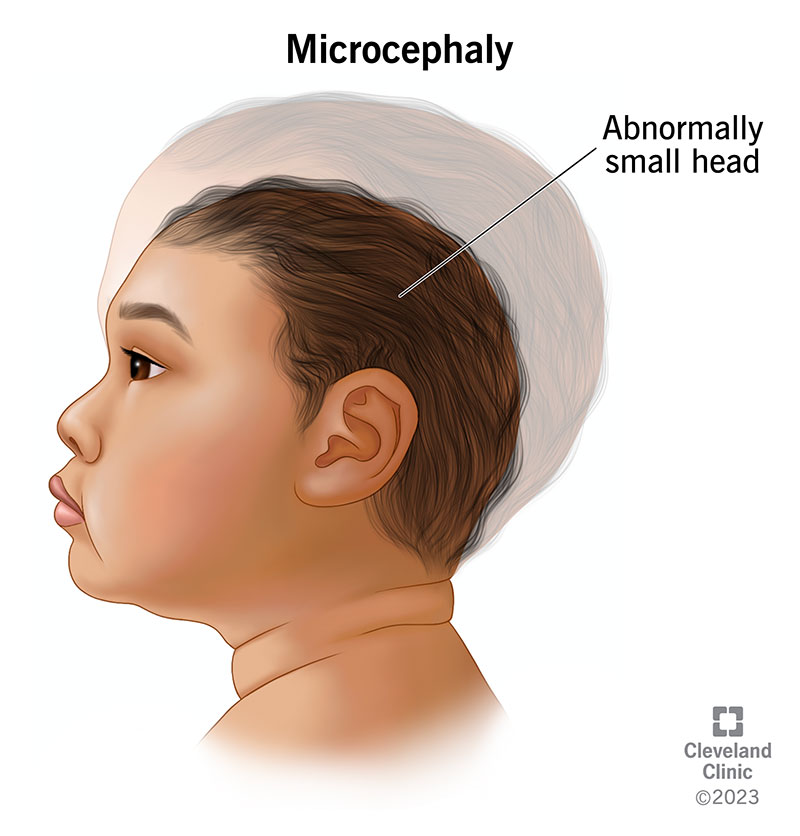Microcephaly is a condition that causes your baby’s head to be smaller than expected. Your baby can be born with a small head or this can become more apparent as they grow. Your baby could have no additional symptoms or the condition can affect their ability to learn and meet developmental milestones for their age. Supportive care and monitoring are important.
Advertisement
Cleveland Clinic is a non-profit academic medical center. Advertising on our site helps support our mission. We do not endorse non-Cleveland Clinic products or services. Policy

Microcephaly is a condition that causes your baby’s head to be smaller than expected for their size and age. Microcephaly happens when your baby’s brain needs more time to grow or doesn’t develop completely. The size of your baby’s skull depends on the size of their brain. Brain growth happens during fetal development and infancy.
Advertisement
Cleveland Clinic is a non-profit academic medical center. Advertising on our site helps support our mission. We do not endorse non-Cleveland Clinic products or services. Policy
There are two types of microcephaly:
Microcephaly is rare. Research estimates it affects about 1 in every 800 to 5,000 babies in the United States.
A small head is the main symptom of microcephaly. The size of your brain influences the size of your head.
Growth abnormalities of the brain can affect how your baby’s brain functions, which can cause additional symptoms. These range in severity and can include:
Symptoms can be life-threatening if they’re severe. Some babies have no symptoms other than a small head.
As your child grows older, their face continues to grow while their skull doesn’t. This can cause your child to develop a large face in comparison to their head size. In addition, they may experience:
A lack of brain growth or changes to how your child’s brain grows can cause microcephaly.
Advertisement
Some causes of microcephaly include:
Your child may be more at risk of developing microcephaly if they had exposure to the following during fetal development:
Microcephaly can be life-threatening if symptoms are severe. It’s difficult to predict how the abnormal development of your child’s brain will affect their growth, so they may need lifelong support and monitoring to prevent complications.
A healthcare provider can sometimes diagnose microcephaly before birth by prenatal ultrasound. This diagnosis, with the fetus still in the uterus, happens late in the second trimester or the third trimester.
A diagnosis most often happens within 24 hours after your baby is born. A healthcare provider will measure your baby’s head circumference (all the way around). Then, they’ll compare your baby’s measurement to growth standards for their age, which takes into account your baby’s length and weight.
If your baby has acquired microcephaly, a healthcare provider will diagnose the condition in infancy when symptoms become apparent. During a physical exam, your baby’s healthcare provider will measure your child’s head circumference. They may ask questions about your child’s progress in reaching developmental milestones for their age, like crawling or walking.
A percentile is a number on a scale of 1 to 100 that shows how a person compares to others. Percentiles help healthcare providers diagnose certain conditions. To receive a microcephaly diagnosis, your baby's head circumference must be in the 3rd percentile or lower. A head circumference in the 3rd percentile means 3% of all infants have a smaller head size, and 97% have a larger head size.
If your child’s healthcare provider suspects microcephaly, they’ll measure your child’s head circumference and run tests to determine the cause. Tests could include:
Treatment for microcephaly focuses on managing symptoms of the condition and could include:
Advertisement
Before your child begins treatment, talk to their healthcare provider about the possible side effects, especially if they’re starting a new medication. Your child’s provider can walk you through what to look out for.
While there’s no cure for microcephaly, treatment is available to help your child manage any symptoms. Providers usually don’t know the extent of microcephaly until your child grows and develops. Their healthcare provider will monitor them through infancy and childhood to make sure there aren’t any complications.
Your child’s care team will usually consist of pediatricians, neurologists and therapists who can provide treatment, education and guidance to improve their health and well-being.
The prognosis depends on the severity of the condition. In some cases, a child won’t have complications and will have a normal life expectancy. More severe cases can reduce your child’s life expectancy. Their risk is higher if the condition affects their brain function.
You can reduce your child’s risk of microcephaly by taking care of yourself during pregnancy. This could include:
Advertisement
Talk to your healthcare provider about ways that you can stay healthy during pregnancy.
Visit your child’s healthcare provider if they:
Contact 911 or your local emergency services number if your child has a seizure.
Microcephaly is a condition that causes your baby’s head to be smaller than expected. It can be concerning to learn that your baby’s head is smaller than expected. Your baby’s healthcare provider and care team will monitor your baby’s development and provide services to help them. Contact your child’s provider if they miss milestones for their age, like walking and saying their first words. Early intervention can help your child as they grow.
Advertisement
As your child grows, you need healthcare providers by your side to guide you through each step. Cleveland Clinic Children’s is there with care you can trust.

Last reviewed on 04/17/2023.
Learn more about the Health Library and our editorial process.